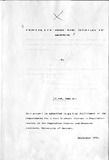| dc.description.abstract | This study has looked into the association between the status of women and fertility behavior in three provinces in Kenya; these ate : Nairobi, Coast and
Western Provinces.
The "status of women" has been represented by women’s work status. Other background factors such as religion and province have also been analysed. Fertility behaviour, on the other hand has been represented by Total Fer tility Rate (TFR). Cross-tabulation has been used to analyse the impact of these socio-economic and socio-cultural factors on fertility behaviour' using the Kenya Demographic and Health Survey <1907)
The findings show that women’s education and work status has a negative impact on fertility behaviour, lire effect of religion, however , was trot conclusive. A comparison of the three provinces revealed the existence of differentials in (TFR) for all the independent variables according to rural-urban setting. Thus Nairobi had the lowest TFR, Western Province the highest TFR, with Coast Province lying in between the
two .
Therefore promotion of socio-economic development in general and improvement in the status of women in particular will be a means of reducing fertility levels in Kenya. | |

